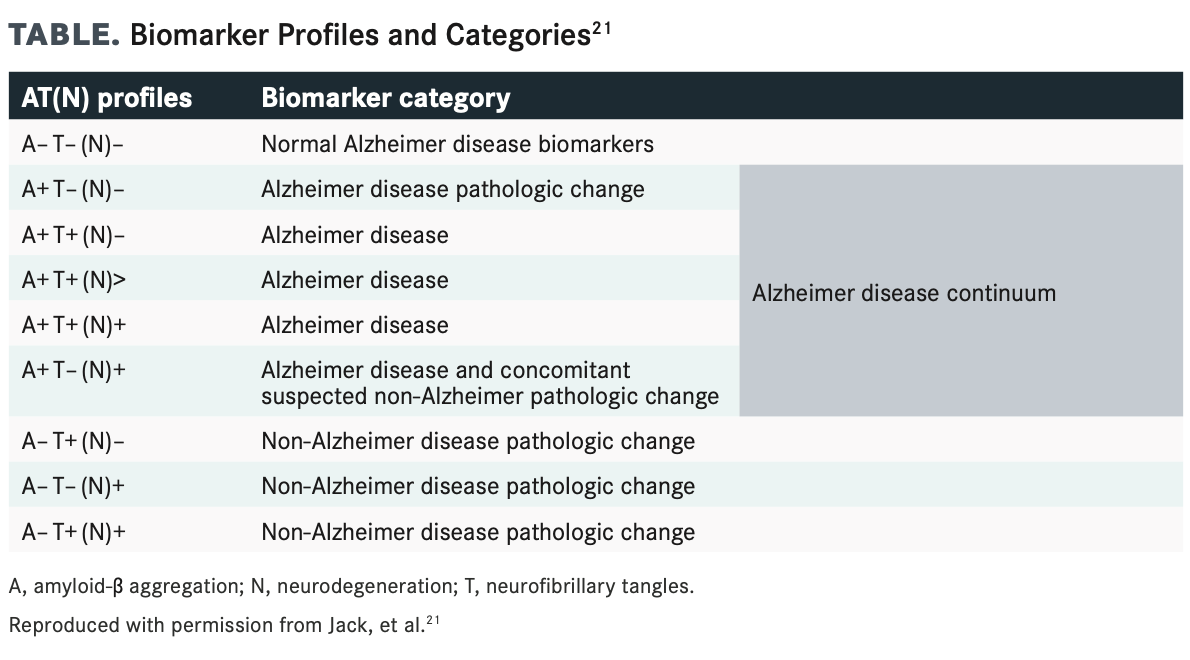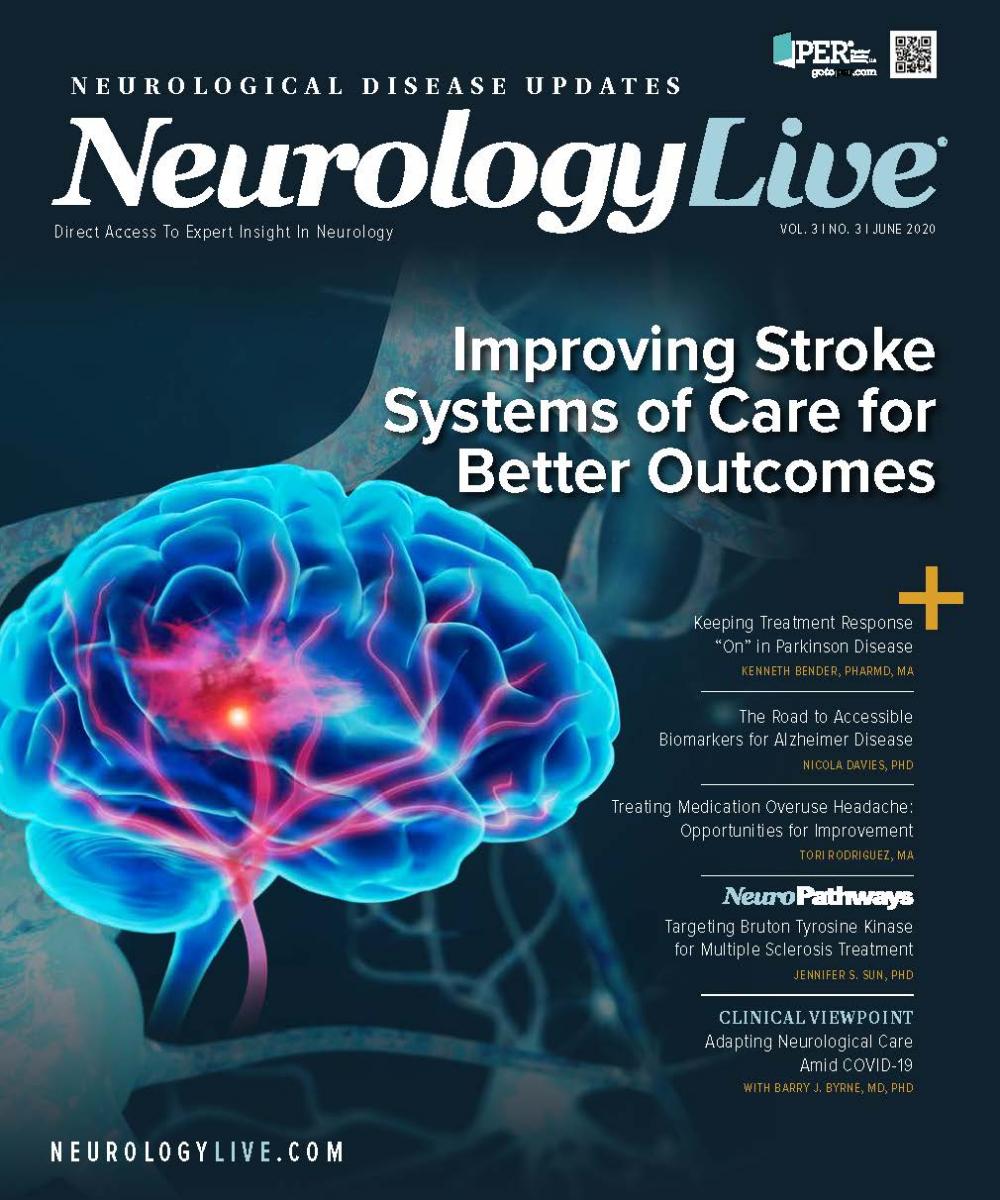Publication
Article
NeurologyLive
The Road to Accessible Biomarkers for Alzheimer Disease
Author(s):
Biomarkers in the cerebrospinal fluid and blood could hold the key to early diagnosis of Alzheimer disease.

Rebecca M. Edelmayer, PhD
Four decades ago, a biological diagnosis of Alzheimer disease (AD) was possible only postmortem. Clinicians had to make a diagnosis on the basis of cognitive impairment and behavioral changes, typically when the patient had already progressed to late-stage dementia.1 However, advancements in the understanding of AD pathology have led investigators to believe that circulating biomarkers carry the potential to revolutionize early diagnosis of AD. It all began with the development of neuroimaging techniques in the early 2000s, which enabled the visualization of a diseased AD brain, revealing abnormal protein plaques and neurofibrillary tangles.2
A Heterogenous Pathology
Interneuronal plaques contain an aggregation of amyloid-β (Aβ) peptides. These are formed by the sequential proteolytic processing of glycoproteins called amyloid precursor proteins. However, overproduction and/or reduced clearance may contribute to the aggregation of Aβ oligomers, resulting in the formation of plaques and trig- gering further Aβ overproduction.3 In contrast, tau tangles can form independent of Aβ pathology by the misfolding of microtubule- associated tau proteins, leading to their aggregation within neurons.4 Interestingly, Aβ and tau protein aggregation-mediated synaptic loss and cell death predate the development of cognitive symptoms by more than 2 decades, raising questions about the cause-effect relationship.5
Currently, clinicians use a combination of MRI/ positron emission tomography (PET), psychological tests, and assessments to diagnose AD and track disease progression.6 However, the degree of pathologic change is not always the same in all subjects, and some uncertainty remains regarding how much change defines the disease.7,8 This complex and heterogenous pathology has hindered the elucidation of the onset, progression, and sequence of events in AD.9
The Need for Early Diagnosis
The detailed neurophysiological evaluations required for AD diagnosis place undue burden on resource-limited health care systems.10 Furthermore, cognitive examinations are subject to bias and may be incorrectly scored because of lack of training.11 Although PET and MRI scans can reveal AD neuropathology with high accuracy, their invasive nature and high costs place these diagnostics out of reach of many patients visiting primary care centers.12-14
“Diagnosis earlier in the disease process means that a person may benefit more from new treatments once they become available,” said Rebecca M. Edelmayer, PhD, director of scientific engagement at the Alzheimer’s Association in Chicago, Illinois. “Even in the absence of such treatments, dementia that is early and accurately diagnosed can be managed with current drug and nondrug interventions, whereas undiagnosed dementia cannot.” A growing consensus among experts is that biomarkers in the blood and cerebrospinal fluid (CSF) may facilitate early diagnosis, even before symptoms of dementia manifest.
Cerebrospinal Fluid Biomarkers
Biomarkers Aβ1-42, phospho-tau (P-Tau), and total-tau (T-tau) in the CSF reflect 3 distinct pathologies associated with the AD brain: Aβ aggregation (A), neurofibrillary tangles (T), and neurodegeneration (N), respectively.15 The Aβ peptide Aβ1-42, which comprises
42 amino acids, aggregates in the AD brain, leading to their decrease in the CSF. In contrast, neurofibrillary tau tangles accumulated in neurons are released by neurodegeneration into the CSF, leading to increasing tau concentrations in patients with AD.16
CSF measurements of Aβ42, T-tau, and P-tau 181 accurately differentiate patients with AD from cognitively healthy individuals and those with some other neurodegenerative dementias.16-18
“Biomarkers assessed in the CSF support the early detection, diagnosis, and classification of Alzheimer disease even at the prodromal stage, with a sensitivity and specificity of more than 85%,” Harald Hampel, MD, PhD, MSc, MA, chief medical officer at Eisai Inc in Woodcliff Lake, New Jersey, told NeurologyLive®. “In addition, CSF biomarkers represent a reliable tool for the prediction of cognitve decline in cognitively healthy older adults and individuals with subjective cognitive decline, a known risk factor for Alzheimer disease.” Interestingly, a study of individuals carrying dominantly inherited AD mutations showed that CSF biomarkers were upregulated 10 to 15 years before the first symptoms of dementia.19 Furthermore, in a longitudinal study that analyzed aging participants without dementia, those with A+ T+ N+ (amyloid/ tau/neurodegeneration abnormality [+]) displayed the most rapid decline in cognitive memory.20
Based on these findings, the National Institute on Aging and the Alzheimer’s Association have proposed a research framework for the diagnosis of AD using an AT(N) scale (TABLE).21

Blood Biomarkers
Aβ40/42 and tau
“Several studies have demonstrated that the plasma Aβ1-42 to Aβ1-40 ratio performs well in indicating the presence of brain amyloidosis [as assessed using PET scanning] in AD, even during prodromal/ preclinical stages,” Hampel said.
The Aβ1-42 to Aβ1-40 ratio has recently been suggested to further improve diagnostic accuracy and show a better concordance with amyloid-PET positivity. A potential explanation for this result is that Aβ1-40 serves as a proxy for “total” Aβ production, with the ratio normalizing for differences in basal Aβ production between individuals or normalizing for between-individual differences in CSF/ plasma dynamics or preanalytical confounders affecting both Aβ1-42 and Aβ1-40.9 Study results have shown that plasma Aβ42 and Aβ40 is nearly as accurate as PET imaging, with several patients who displayed abnormal ratios going on to develop AD symptoms within 5 years.22 Plasma T-tau protein concentrations detected using novel immunoassay techniques have also successfully differentiated between controls and patients with AD.23 More recently, plasma P-tau was found to be progressively increased in preclinical AD, mild cognitive impairment, and AD dementia. Furthermore, the values correlated with CSF P-tau measurements and tau PET.24
Apoliprotein E
Characterization of amyloid plaque aggregation in the AD brain has also led to the discovery of apolipoprotein in these peptide clusters. The discovery of apolipoprotein and associated dysregulation in lipid metabolism has elucidated associations among AD, cardiovascular disease, hypertension, insulin resistance, and diabetes.25
Apolipoprotein aggregation results from a distinct mutation in the APOE gene; the ɛ4 allele of APOE is the most significantly associated mutation with AD, as verified in American, European, and Australian cohorts.26 A more recent study also confirmed that life-long exposure to APOE (resulting from APOE muta- tion) led to an increased risk of dementia.27 The Australian Imaging Biomarkers and Lifestyle Study of Ageing (AIBL) found that subjects carrying the ɛ4 allele of APOE who had mild cognitive impairment showed a greater decline in cognitive abilities.28 Therefore, sequencing of this allele could help identify high-risk cohorts, aiding early diagnosis.
“Other genetic polymorphisms can also interact with APOE, and others like brain-derived neurotrophic factor and Klotho may affect rates of decline,” said Colin Masters, MBBS, MD, of the University of Melbourne in Australia, who leads the Neuropathology and Neurodegeneration Laboratory at The Florey Institute of Neuroscience and Mental Health and who led the AIBL study. “We therefore look forward to the new generations of anti-Aβ therapy, which are looking promising.” Investigators are currently studying in clinical trials novel anti-Aβ monoclonal antibodies including BAN2401 (Eisai and Biogen), aducanumab (Biogen), and gantenerumab (Roche), which are designed to bind and remove Aβ aggregations.
Neurofilament light
Another exciting biomarker on the horizon is neurofilament light (NfL), a protein building block of axons that accumulate in the CSF following neurodegeneration in the AD brain.29 Furthermore, serum concentrations of NfL correlate with CSF levels, suggesting blood measurements could be used to detect brain pathologies.30 Study results have shown NfL levels to be upregulated even in those patients with dominant AD mutations presenting without symptoms of dementia, indicating that NfL could be an early biomarker of neurodegeneration.31
Notably, however, NfL is a general indicator of neurodegeneration, not specific to AD. Still, in primary care settings, NfL could help identify in a noninvasive and cost-effective manner those patients who need further assessment.9
From Clinical Trials to Market: What Lies Ahead?
Although these biomarkers look promising, their commercialization and wide adoption hinge on further research. “Accurate blood biomarkers would be a real boon to researchers, clinicians, and the public because of the ease, simplicity, accessibility, and lower cost of administering and evaluating them,” said Edelmayer. “Improvements in sensitivity of the assays have changed the ability to measure some of these markers, even in blood. That said, biofluids are still in a stage of validation. Comparing biofluid data with the gold-standard imaging biomarkers, and correlating them to cognitive and functional abilities, helps to build confidence, standards, and validation of biofluid technologies.”
In this respect, the Alzheimer’s Association is engaged in several efforts, including the Global Biomarker Standardization Consortium, which seeks consensus on the best ways to standardize and validate biomarker tests for use in global clinical practices. Also, the Accelerating Medicines Partnership - Alzheimer’s Disease project—a precompetitive partnership among government, industry, and nonprofit organizations—is focused on discovering novel, clinically relevant therapeutic targets and developing biomarkers to help vali- date existing therapeutic targets.
Furthermore, assay reliability, replication, and validation by independent studies in diverse cohorts are critical.9 “Among the various recommendations and solutions going forward, the recent development of fully automated assays provides the basis for the development of globally replicable and accepted cutoff points,” Hampel said. “Compared with traditional protocols, fully automated assays significantly minimize critical factors that influence the accuracy and replicability of the test. Eisai, in collaboration with its partners, is currently developing a fully automated assay for measuring Aβ in plasma.”
Investigators may also need to analyze individual variability in biomarker concentrations. “Validating the technologies in diverse populations will be key to driving accuracy and predictability of these technologies,” Edelmayer added.
“One such avenue that has not been sufficiently explored is [sex] differences,” Michelle M. Mielke, PhD, professor of epidemiology and neurology at Mayo Clinic in Rochester, Minnesota, told NeurologyLive®. “Sex differences can lead to marked effects on the measurement and interpretation of AD biomarkers. For example, the effect of menopause and subsequent use of menopausal hormone therapy on blood and CSF AD biomarkers have not been adequately assessed.”
The modulation of the blood-brain barrier does demonstrate differences in sex.32 “However, the overwhelming majority of studies that examined fluid biomarkers have adjusted for sex,” Mielke said. “This is problematic because adjusting for sex treats it as a nuisance variable,
an unwanted variable that influences the relationship between the independent and dependent variable.” Therefore, landmark studies may have ignored marked differences in sex that influence the interpretation of biomarker levels.
In contrast with the use of single biomarkers, in the future, a panel-based assay that uses a combination of biomarkers may also prove more sensitive in detecting AD. However, inclusion of multiple biomarkers could complicate commercial development, validation, standardization, and FDA approval of these tools and diagnostics. The increased costs of such an assay may also limit widespread adoption.33,34
Hampel suggested a different strategy. “Because the complete clinical development and standardization of blood-based biomarkers will probably take some more years, it is key to leverage the currently available mature validated CSF biomarkers based on lumbar puncture and laboratory analysis for the early detection of AD,” he said. “The main challenge related to CSF biomarkers is a reluctance by many physicians to adopt and perform lumbar puncture procedures because of its perceived invasiveness. However, several large-scale studies have demonstrated a very low incidence of any significant adverse events, particularly in an aging population. The physicians’ perception largely impacts the patient’s willingness to undergo the procedure. We must increase awareness and acceptance of this very practical and useful diagnostic approach on a global level.”
The Future
Biomarker discovery is a rapidly growing interest in AD research. Apart from the core markers currently in research (Aβ42, P-tau, and T-tau), a recent meta-analysis found more than 15 validated biomarkers of neurodegeneration, amyloid, and tau pathologies that demonstrate impressive diagnostic performance. Subsequently, the AlzBiomarker database has been developed with clinical data and results from studies of potential biomarkers, with the intention to consistently add new data when they are published.35 With the consolidated efforts of experts from around the world, the neurology community is 1 step closer to the reality of developing a novel blood test for AD diagnosis.
REFERENCES
1. Wade JPH, Mirsen TR, Hachinski VC, Fisman M, Lau C, Merskey H. The clinical diagnosis of Alzheimer’s disease. Arch Neurol. 1987;44(1):24-29. doi:10.1001/archneur.1987.00520130016010
2. Ferreira LK, Busatto GF. Neuroimaging in Alzheimer’s disease: current role in clinical practice and potential future applications. Clinics (Sao Paulo). 2011;66(suppl 1):19-24. doi:10.1590/S1807-59322011001300003
3. Selkoe DJ, Hardy J. The amyloid hypothesis of Alzheimer’s disease at 25 years. EMBO Mol Med. 2016;8(6):595-608. doi:10.15252/emmm.201606210
4. van der Kant R, Goldstein LSB, Ossenkoppele R. Amyloid-β-independent regulators of tau pathology in Alzheimer disease. Nat Rev Neurosci. 2020;21(1):21-35. doi:10.1038/s41583-019-0240-3
5. Bloom GS. Amyloid-β and tau: the trigger and bullet in Alzheimer disease pathogenesis. JAMA Neurol. 2014;71(4):505-508. doi:10.1001/jamaneurol.2013.5847
6. Young PNE, Estarellas M, Coomans E, et al. Imaging biomarkers in neurodegeneration: current and future practices. Alzheimers Res Ther. 2020;12(1):49. doi:10.1186/s13195-020-00612-7
7. Serrano-Pozo A, Qian J, Monsell SE, et al. Mild to moderate Alzheimer dementia with insufficient neuropathological changes. Ann Neurol. 2014;75(4):597-601. doi:10.1002/ana.24125
8. Nelson PT, Head E, Schmitt FA, et al. Alzheimer’s disease is not “brain aging”: neuropathological, genetic, and epidemiological human studies. Acta Neuropathol. 2011;121(5):571-587. doi:10.1007/s00401-011-0826-y
9. Hampel H, O’Bryant SE, Molinuevo JL, et al. Blood-based biomarkers for Alzheimer disease: mapping the road to the clinic. Nat Rev Neurol. 2018;14(11):639-652. doi:10.1038/s41582-018-0079-7
10. El-Hayek YH, Wiley RE, Khoury CP, et al. Tip of the iceberg: assessing the global socioeconomic costs of Alzheimer’s disease and related dementias and strategic implications for stakeholders. J Alzheimers Dis. 2019;70(2):323-341. doi:10.3233/JAD-190426
11. Cannon P, Larner AJ. Errors in the scoring and reporting of cognitive screening instruments administered in primary care. Neurodegener Dis Manag. 2016;6(4):271-276. doi:10.2217/nmt-2016-0004
12. Adlard PA, Tran BA, Finkelstein DI, et al. A review of β-amyloid neuroimaging in Alzheimer’s disease. Front Neurosci. 2014;8:327. doi:10.3389/fnins.2014.00327
13. Jack CR, Barnes J, Bernstein MA, et al. Magnetic resonance imaging in Alzheimer’s Disease Neuroimaging Initiative 2. Alzheimers Dement. 2015;11(7):740-756. doi:10.1016/j.jalz.2015.05.002
14. Matsuda H, Shigemoto Y, Sato N. Neuroimaging of Alzheimer’s disease: focus on amyloid and tau PET. Jpn J Radiol. 2019;37(11):735-749. doi:10.1007/s11604-019-00867-7
15. Jack CR, Bennett DA, Blennow K, et al. A/T/N: an unbiased descriptive classification scheme for Alzheimer disease biomarkers. Neurology. 2016;87(5):539-547. doi:10.1212/WNL.0000000000002923
16. Niemantsverdriet E, Valckx S, Bjerke M, Engelborghs S. Alzheimer’s disease CSF biomarkers: clinical indications and rational use. Acta Neurol Belg. 2017;117(3):591-602. doi:10.1007/s13760-017-0816-5
17. Sunderland T, Linker G, Mirza N, et al. Decreased beta-amyloid1-42 and increased tau levels in cerebrospinal fluid of patients with Alzheimer disease. JAMA. 2003;289(16):2094-2103. doi:10.1001/jama.289.16.2094
18. Aisen PS, Vellas B, Hampel H. Moving towards early clinical trials for amyloid-targeted therapy in Alzheimer’s disease. Nat Rev Drug Discov. 2013;12(4):324. doi:10.1038/nrd3842-c1
19. Fagan AM, Xiong C, Jasielec MS, et al; Dominantly Inherited Alzheimer Network. Longitudinal change in CSF biomarkers in autosomal-dominant Alzheimer’s disease. Sci Transl Med. 2014;6(226):226ra30. doi:10.1126/scitranslmed.3007901
20. Jack CR Jr, Wiste HJ, Therneau TM, et al. Associations of amyloid, tau, and neurodegeneration biomarker profiles with rates of memory decline among individuals without dementia. JAMA. 2019;321(23):2316-2325. doi:10.1001/jama.2019.7437
21. Jack CR, Bennett DA, Blennow K, et al. NIA-AA research framework: toward a biological definition of Alzheimer’s disease. Alzheimers Dement. 2018;14(4):535-562. doi:10.1016/j.jalz.2018.02.018
22. Kaneko N, Nakamura A, Washimi Y, et al. Novel plasma biomarker surrogating cerebral amyloid deposition. Proc Jpn Acad Ser B Phys Biol Sci. 2014;90(9):353-364. doi:10.2183/pjab.90.353
23. Zetterberg H, Wilson D, Andreasson U, et al. Plasma tau levels in Alzheimer’s disease. Alzheimers Res Ther. 2013;5(2):9. doi:10.1186/alzrt163
24. Janelidze S, Mattsson N, Palmqvist S, et al. Plasma P-tau181 in Alzheimer’s disease: relationship to other biomarkers, differential diagnosis, neuropathology and longitudinal progression to Alzheimer’s dementia. Nat Med. 2020;26(3):379-386. doi:10.1038/s41591-020-0755-1
25. Kulas JA, Weigel TK, Ferris HA. Insulin resistance and impaired lipid metabolism as a potential link between diabetes and Alzheimer’s disease. Drug Dev Res. 2020;81(2):194-205. doi:10.1002/ddr.21643
26. Martins RN, Villemagne V, Sohrabi HR, et al. Alzheimer’s disease: a journey from amyloid peptides and oxidative stress, to biomarker technologies and disease prevention strategies—gains from AIBL and DIAN cohort studies. J Alzheimers Dis. 2018;62(3):965-992. doi:10.3233/JAD-171145
27. Rasmussen KL, Tybjærg-Hansen A, Nordestgaard BG, Frikke-Schmidt R. Plasma apolipoprotein E levels and risk of dementia: a Mendelian randomization study of 106,562 individuals. Alzheimers Dement. 2018;14(1):71-80. doi:10.1016/j.jalz.2017.05.006
28. Albrecht MA, Szoeke C, Maruff P, et al; AIBL Research Group. Longitudinal cognitive decline in the AIBL cohort: the role of APOE ε4 status. Neuropsychologia. 2015;75:411-419. doi:10.1016/j.neuropsychologia.2015.06.008
29. Olsson B, Portelius E, Cullen NC, et al. Association of cerebrospinal fluid neurofilament light protein levels with cognition in patients with dementia, motor neuron disease, and movement disorders. JAMA Neurol. 2019;76(3):318-325. doi:10.1001/jamaneurol.2018.3746
30. Gisslén M, Price RW, Andreasson U, et al. Plasma concentration of the neurofilament light protein (NFL) is a biomarker of CNS injury in HIV infection: a cross-sectional study. EBioMedicine. 2016;3:135-140. doi:10.1016/j.ebiom.2015.11.036. Published correction appears in EBioMedicine. 2016;7:287-288. doi:10.1016/j.ebiom.2016.04.021
31. Weston PSJ, Poole T, Ryan NS, et al. Serum neurofilament light in familial Alzheimer disease: a marker of early neurodegeneration. Neurology. 2017;89(21):2167-2175. doi:10.1212/WNL.0000000000004667
32. Diler AS, Uzüm G, Akgün Dar K, Aksu U, Atukeren P, Ziylan YZ. Sex differences in modulating blood brain barrier permeability by NO in pentylenetetrazol-induced epileptic seizures. Life Sci. 2007;80(14):1274-1281. doi:10.1016/j.lfs.2006.12.039
33. Counts SE, Ikonomovic MD, Mercado N, Vega IE, Mufson EJ. Biomarkers for the early detection and progression of Alzheimer’s disease. Neurotherapeutics. 2017;14(1):35-53. doi:10.1007/s13311-016-0481-z
34. Hampel H, Frank R, Broich K, et al. Biomarkers for Alzheimer’s disease: academic, industry and regulatory perspectives. Nat Rev Drug Discov. 2010;9(7):560-574. doi:10.1038/nrd3115
35. Olsson B, Lautner R, Andreasson U, et al. CSF and blood biomarkers for the diagnosis of Alzheimer’s disease: a systematic review and meta-analysis. Lancet Neurol. 2016;15(7):673-684. doi:10.1016/S1474-4422(16)00070-3





